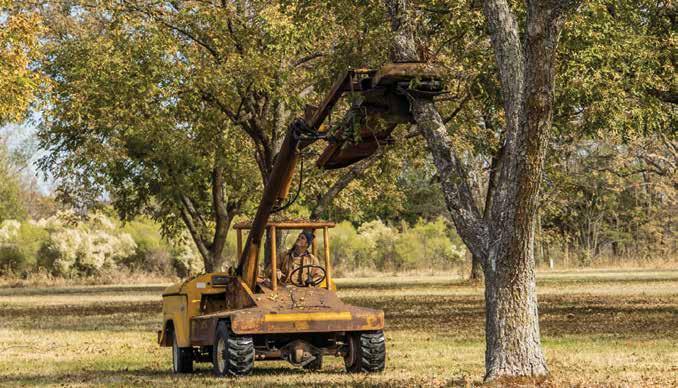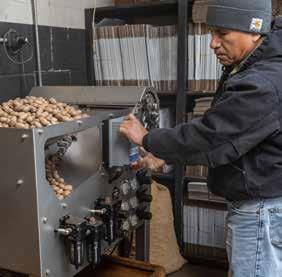












they’ll carry with them. I get it, you want to give them every possibility for a future full of hope and opportunity
I know that life insurance isn’t just about a check—it’s about so much more. family and maintain their standard of living. Contact an Arkansas Farm Bureau agent today.






Official membership publication of Arkansas Farm Bureau Federation mailed to almost 190,000 member-families.

Included in membership dues

A RKANSAS FARM BUREAU OFFICERS:
President • Rich Hillman, Carlisle
Vice President • Mike Freeze, Little Rock
Secretary/Treasurer • Dan Wright, Waldron
DIRECTORS:
Magen Allen, Bismarck
Jon Carroll, Moro
Terry Dabbs, Stuttgart
Brad Doyle, Weiner
Jack Evans, Lonoke
Sherry Felts, Joiner
Chase Groves, Garland City
Jason Henson, Mount Judea
Terry Laster, Strong
Caleb Plyler, Hope
Bob Shofner, Centerton
Dana Stewart, Judsonia
Joe Thrash, Houston
EX OFFICIO
Nita Cooper, Everton
Monica Paskewitz, Melbourne
Kerry Stiles, Marianna
Reed Storey, Marvell
Executive Editor • Steve Eddington
Contributing Writers • Dwain Hebda, Shaylee Wallace Barber, Chad Hooten
CREATED BY PUBLISHING CONCEPTS, INC
David Brown, President dbrown@pcipublishing.com (501) 221-9986 ext. 103 Fax (501) 225-3735
ADVERTISING
Contact Paula Caruthers at Publishing Concepts for advertising rates pcaruthers@pcipublishing.com (501) 221-9986, Ext. 109 Fax (501) 225-3735

Front Porch (USPS 019-879) is published quarterly by the Arkansas Farm Bureau Federation 10720 Kanis Rd., Little Rock, AR 72211
Periodicals Postage paid at Little Rock, AR
POSTMASTER: Send address changes to Rhonda Whitley at rhonda.whitley@arfb.com
Front Porch • P.O. Box 31 • Little Rock, AR 72203
Please provide membership number
Issue #125
Publisher assumes no responsibility for any errors or omissions. All rights reserved. Reproduction without permission is prohibited.
The Arkansas Farm Bureau Federation reserves the right to accept or reject all advertising requests.









For over 70 years Farm Bureau® Insurance’s commitment to our customers has never wavered. In that time, local agents and adjusters have served communities all over Arkansas with home and auto insurance, and more. We believe that your family is part of our family. And protecting families has always been our pledge. Talk with your local agent to learn more about the Farm Bureau Promise.






Westrock opened the Mwito pre-primary school in 2019 in the African country of Rwanda to celebrate 10 years of partnership in the country. The school can serve 320 students.

Westrock Coffee co-founders Joe (left) and Scott Ford rang the opening bell on the NASDAQ Exchange in late August, setting off a celebration and becoming the newest publicly traded Arkansas-based company. Westrock has grown through expansion and acquisition and now provides more than 20 million cups of coffee daily.

Westrock’s first employees included more than 20 Rwandans. Today the company employs 1,200 people in operations across 10 countries, leveraging relationships with 1.5 million farmer partners from 35 nations.

“We’ve left countries because the government said, ‘We don’t want you paying farmers, we want you to pay us and then we’ll disperse to the farmer what we think is fair’,” CEO Scott Ford says. “When they try to say, ‘You can’t do business in this area,’ or ‘You can’t pay that price,’ or ‘You have to pay at least this price, even though it’s not worth it.’ When they get into that business, everything goes sideways.”


Did you know the Arkansas Game and Fish Commission offers wildlife management assistance for private land?


If you are a landowner, you could receive habitat recommendations from our statewide staff of private lands biologists.
Visit AGFC.com/habitat to learn more about Private Lands Programs available to you.



Thank the flood of 1927 for your recent holiday treats featuring Arkansas pecans.
The sandy, alluvial soil left behind from the most destructive waters in state history (36 of 75 counties were submerged up to 30-feet deep) helps farmers annually harvest more than 2.5 million pounds of pecans. Gorgeous groves near the Arkansas, St. Francis, Red and Mississippi Rivers are the state’s top producers.
In Keo (population 246), 20 miles southeast of Little Rock and 6 flat miles from the Arkansas River, 49-year-old Shane Cummings farms 375 acres of mature pecan trees. Most are decades old, but they still produce 400-500,000 pounds annually, about 20 percent of the state’s yield.
The Nut House, a 200-square foot building with a tilted ceiling window originally used to grade cotton,
 photos by Shaylee Wallace Barber
photos by Shaylee Wallace Barber
sits seven steps from Cummings’ office at 474 Main Street in downtown Keo. Two men work in the hut, shaking, sifting, weighing and packing pecans for purchase. A 5-pound box cost $35 this year, but they are orchard fresh, tastier and still more affordable than grocers.
Harvest season hits as the holidays arrive. From mid-October through December, tractor-powered tree shakers grab the bigger branches to jar loose the nuts. Cummings says pecans haven’t been picked up by hand since the early 1970s. Instead, a harvester attached with finger-like sweepers picks them up and sorts out leaves and twigs. They are cleaned, again, of remaining debris by hand before being placed in a drying bin for 4-6 hours and moved to the Nut House to be cracked into halves.

“People are always excited when they come out here,” Cummings says. “It’s kind of a nice thing to produce something that people can use and eat. You have some pride in the quality of your pecans.”
The nuts natural sweetness and crispness adds depth of flavor and a nice crunch to popular Arkansas holiday sweets, like pecan pie, shortbread, brittle and pralines. They also add some crispness to fluffy pancakes and their salty sweetness is the perfect companion to a bowl of vanilla ice cream.
The Nut House sells up to 30,000 pounds of “the really nice ones” in downtown Keo. The rest go into massive wholesale bags weighing 2,000 pounds and are shipped to Greenville, Miss.

Cummings married into this business. His wife, known to drop pecans in her chocolate-chip cookie dough, grew up in Little Rock but spent a lot of
time in Keo at her grandad’s farm. J.D. Cobb’s land included a small orchard planted around World War II. He added more than 300 acres in 1966 by turning cotton land into a grafted pecan orchard. He planted trees 66 feet apart or about 10 per acre to total 3,700.
“Over the years we have lost some trees and typically haven’t replaced them,” Cummings says. “A lot of our orchards are verging on overcrowded. There is part of me that would like to thin them out so they could get more sunlight. Larger, mature trees like more space for light and air movement.”
There are more than 500 kinds of pecan trees that can grow up to 75-feet tall with a 40-foot spread, but most farms in Arkansas only cultivate a handful of varieties. Forket, Pawnee, Elliot and Desirable are well-known types. Cummings trees are mostly Desirables – an excellent sheller producing humongous halves. Many believe it was one of the first pecan cultivars developed from a controlled cross in the early 1900s.
“Pecan trees are fickle, notorious for being alternate bearing,” Cummings says. “They’ll have an on-year and then an off-year. None of my orchards are irrigated so I think that contributes to (lower production). This summer was dry, so we had a lot of nut drop.”
Cummings plans to start irrigating this year,
A harvester attached with finger-like sweepers (top photo) picks up the pecans and sorts out leaves and twigs. Then the nuts are cleaned, again, by hand, of remaining debris before being placed in a drying bin for 4-6 hours and moved to the Nut House in Keo to be cracked into halves.
hoping for more consistent harvests but says his biggest challenge – labor – will remain. Disease pressure, stink bugs, black aphids and other insects, soil treatment and irrigation keep pecan growers hustling year-round.


“There is a lot of handwork involved in this,” Cummings says while standing at the edge of one of his shady orchards. “I’ve got a guy who mows pretty much all year. That’s all he does, mow with a 15-foot batwing cutter behind his tractor. It makes the orchard look nice and cuts down on grass stealing nutrients in the soil. And, at this point, there is not a machine to pick up all the limbs and debris. I’ve got a guy who drives

around with a little dump trailer all day picking up branches all summer and fall.”
Cummings and his crew invest a minimum of 120 hours per week, he says.
Pecans are the only major tree nut native to the United States. Evidence shows Native Americans collected pecans before the 1800s.
The pecan market started in Louisiana and migrated up the Mississippi. Those native trees, sprouted from a pecan in the ground and typically found today in yards and around homes, produce smaller nuts.
But with improved and grafted trees, the United States is currently responsible for 80 percent of the world’s pecans. Among the 15 pecan-producing states, Georgia accounts for 88 million pounds (33% of the U.S. harvest) with more than 6,000 trees located mostly in the southwest region of the state.
New Mexico (72 million pounds) and Texas (37 million pounds) rank No. 2 and No. 3, respectively. Arizona ranks fourth.
Time is an issue for Cummings, though. It takes 6 or 7 years before any serious pecan production, even with good-sized grafted trees.
“I will be 50 this year,” he says with a smile. “It would be a challenge for anyone to go and buy some land and plant pecans on it unless you just have some money you are willing to park for a while.”
The USDA reported in 2015 that Arkansas’ pecan production could vastly improve just by fertilizing regularly and routinely taking soil and foliar samples.
The natural sweetness and crispness of pecans add depth of flavor and a nice crunch to popular Arkansas holiday sweets, like pecan pie, shortbread, brittle and pralines. They also add some crispness to fluffy pancakes and their salty sweetness is the perfect companion to a bowl of vanilla ice cream.

Cummings fears his pecans planted in the 1960s will lose their vigor, so he is looking for more land. He envisions rows 100 feet apart but with only 45 feet between the trees. The dream — marketing a million pounds of pecans annually.
“They are developing some new varieties that are pecan scab resistant (a common disease resulting in black speckles on limbs, leaves and hulls causing nuts to abort),” Cummings says. “I’m skeptical, but it will be a half century before we know if it remains resistant. Desirables used to be resistant, too, but the fungus has adapted with time and now my trees are susceptible. You are stuck with the genetic traits of your trees for a long time.”
Consumer demand for pecans continues to grow, up 12-15 percent over the past few years according to the University of Arkansas Division of Agriculture. Apart from the great flavor and taste, pecans have an impressive nutrient profile,
which makes them healthy and wholesome.
Arkansas designated the pecan as its official nut in 2009. They are grown in backyards, orchards and can be found in forests throughout the state. The rich, buttery, and nutty flavor makes it a favorite this time of year.

“At Thanksgiving we used to make pecan pies just using the recipe on the back of Karo syrup bottles, but I just like to eat them,” Cummings says. “We keep some of the cracked pecans and roast them in a pan on the stove at the shop.”
By the way, it’s pronounced “puh-kahn” or “pee-kahn” but never “peeaacan” in Arkansas and agronomists say the state’s soils where other crops struggle can be perfect for them





















If you have any of these symptoms, then you may have a condition known as peripheral neuropathy. Has your doctor told you that nothing can be done to help neuropathy? If so, you may be talking to the wrong doctor. A Free Neuropathy Information Packet is available that reveals how a non-surgical, drugless treatment has helped thousands of neuropathy sufferers overcome this disabling condition. If you suffer from neuropathy, you need to order this Free Information Packet, while supplies last. To receive your Free Information Packet… Call Toll Free (844) 663-6045.


Cavenaugh Ford 2000 E. Highland Drive Jonesboro, AR 72401 870-972-8000

Ford of West Memphis 2400 East Service Rd. West Memphis, AR 72301 870-735-9800 www.fordofwestmemphis.com
Red Taylor Ford, Inc. 401 W. Second St. Corning, AR 72422 870-857-3516 www.redtaylorford.com
Ryburn Motor Company, Inc.
156 Highway 425 South Monticello, AR 71655 870-367-5353 www.ryburnautomotive.com
Cogswell Ford 1900 East Main Russellville, AR 72801 479-968-2665 www.cogswellford.com
Glen Sain Ford, Inc. Danny Ford, owner 1301 Hwy 49 North Paragould, AR 72450 870-236-8546 www.glensainford.net
Riser Harness 2000 E. Race Ave. Searcy, AR 72143 501-268-2486 www.riserharnessford.com
Smith Ford, Inc. 908 E. Oak St. Conway, AR 72032 501-329-9881 www.smithford.net
Vaughn Ford Sales, Inc. 106 Hwy 63 West Marked Tree, AR 72365 870-358-2822 www.vaughnford.com
With the holiday season now gone, many will be looking for that next warm, cozy winter recipe. Whether you’re snowed in with the kids home from school, finishing up chores in the bitter winter winds or just looking for a way to finish off those pecans from the most recent harvest, these recipes have you covered!


Like a great cinnamon roll, but better, these are sure to please! Need to save some time? Grab your favorite premade cinnamon rolls and substitute them for the homemade rolls below!
2 ½ cups of warm milk
2 ¼ teaspoon of active dry yeast ½ teaspoon of white sugar (to pair with yeast)
3 ½ cups of all-purpose flour 1 teaspoon of salt ¼ cup of white sugar 4 tablespoons of butter (softened)
STICKY BUN FILLING
4 tablespoons of butter (melted) ½ cup of brown sugar ½ cup of white sugar
2 teaspoons of cinnamon
8 tablespoons of butter
1 cup of brown sugar ½ teaspoon of cinnamon ¼ cup of heavy cream
A pinch of salt 1 cup of chopped pecans
1. Preheat oven to 350º.
2. Add the yeast and ½ teaspoon of sugar to the warm milk. Allow to sit for five minutes, until frothy.
3. In a stand mixer combine the flour, salt and white sugar (dough ingredients). Pour the yeast mixture into the dry ingredients and knead with a dough hook until combined.
4. Add 4 tablespoons of softened butter to the mixer, 1 tablespoon at a time, and knead on low speed for five minutes.
5. Use your hands to form the dough into a ball, put it back into the bowl. Cover the bowl and rest in a warm spot in your kitchen for 30 minutes (or until doubled in size).
6. Dump the dough out on to a generously floured surface and roll out to a 10x20 inch rectangle.
7. Spread the melted butter over the dough and sprinkle the brown sugar, white sugar and cinnamon to all the edges.
8. Roll up tightly and cut into 8 pieces.
9. In a small saucepan over low heat, add the butter, brown sugar, vanilla, cinnamon, heavy cream and pinch of salt and bring to a slow boil.
10. Reduce heat to low and whisk until the sugar has dissolved.
11. Lightly grease a 9x12 baking pan with butter and pour the caramel sauce into the pan and sprinkle with pecans.
12. Place the sticky buns in the caramel pecan sauce and cover the baking pan and let it rise in a warm place in your kitchen for abut 30 minutes (if using premade cinnamon rolls you can skip the second rising).
13. Bake for 20-25 minutes then remove from the oven and let rest 15 minutes.
Maybe you like your pecans in a more classic winter treat. If so, this pecan pie recipe will be your new go-to.


1 whole unbaked pie crust

1 cup of white sugar
3 tablespoons of brown sugar ½ teaspoon of salt
1 cup of corn syrup
14. After allowing your sticky buns to rest turn your pan over onto another pan or a serving platter, but be careful, the caramel sauce is hot.
15. Serve with your favorite savory breakfast foods and enjoy!
¾ teaspoon of vanilla cup of melted butter (salted)
1 3

3 whole eggs beaten 1 cup of chopped pecans (heaping)
1. Preheat the oven to 350º
2. Whip up your favorite pie crust recipe or grab a store-bought crust and place it in a greased pie dish.
3. Mix the white sugar, brown sugar, salt, corn syrup, melted butter, beaten eggs and vanilla together in a bowl.
4. Pour the chopped pecans in the bottom of your unbaked pie shell.
5. Pour the syrup mixture over the top of your chopped pecans.
6. Cover your pie lightly with foil and bake for 30 minutes.
7. Remove foil and continue baking for 20 more minutes, be careful not to burn the crust or the pecans.
8. Remove from the oven, be sure your pie isn’t too jiggly, if it is then cover your pie with foil and continue to bake in 10 minute intervals until it is finished.
9. Once removed from the oven, allow your pie to cool for several hours or overnight and then serve with your favorite whipped cream or toppings!








The most recent issue of Arkansas Agriculture was the last print version of that publication, but we’re not going away!

The issue of Arkansas Agriculture that you hold in your hands will be the last print version of our publication, but we’re not going away!
Starting in 2023, Arkansas Agriculture will be a fully digital source of news, stories and views on Arkansas’ largest industry. The industry news and content you’ve come to expect from Arkansas Agriculture will now be offered online, along with videos, audio, more photos and other features. We will have more news on this transition soon at the Arkansas Farm Bureau website, arfb.com, and through our e-letter, The Feed, and Arkansas Farm Bureau’s official social media channels, so stay tuned.
Starting in 2023, Arkansas Agriculture will be a fully digital source of news, stories and views on Arkansas’ largest industry. The industry news and content you’ve come to expect from Arkansas Agriculture will now live online, along with videos, audio, more photos and other features. We will have more news on this transition soon at the Arkansas Farm Bureau website, arfb.com, and through our e-letter, The Feed, and Arkansas Farm Bureau’s official social media channels, so stay tuned!
Sign up for The Feed today at arfb.com/thefeed
Sign up for The Feed today at arfb.com/thefeed
Find us online at arfb.com or scan the QR code to access our social media!
Find us online at arfb.com or scan the QR code to access our social media!

With the holidays now behind us, we’ve likely all spent the past few weeks thinking about food. Food memories evoke nostalgia, and nostalgia is the closest thing I know to time travel. The smell of diced onions and celery sautéd in butter always delivers me to a Thanksgiving morning back on the farm. While Momma’s cornbread dressing baked in the kitchen, my sister and I watched the Macy’s Thanksgiving Day Parade in the den. Those savory aromas and the sound of that parade launched the holiday season for me. And they always will.
It probably began with Halloween, though. And fall carnivals. When my sister and I went trick-ortreating around Keiser and Etowah, folks often handed out homemade popcorn balls wrapped in plastic wrap, and some ladies treated us to whole Hershey’s bars. The first time I tasted a caramel apple and ate a corndog at the carnival in Cottonwood Corner, I questioned why fair food didn’t occupy a separate category on the all-important food pyramid.
Thanksgiving brought the Harvest Supper at church, which was by far the best night to be a member of Brinkley Chapel Baptist Church. The astounding variety of casseroles covering the tables in the back room would become the stuff of future potluck dreams. Fried chicken, creamed potatoes, green beans cooked with bits of bacon, deviled eggs, turkey and dressing, sweet potatoes topped with melted marshmallows, and, oh my, the cakes and pies! Harvest Supper was a religious experience unto itself.
Back then, there was no such thing as being a vegetarian, eating gluten-free, or having an intolerance to lactose, not in Mississippi County, anyway. That would have been as crazy as not cheering for the hometown football team.
After Harvest Supper and Thanksgiving, my sister and I counted down to magical, marvelous Christmas. Once again, Brinkley Chapel stands at the forefront of my mind. Immediately following the Christmas program, Jimmy Davis, helping out a much too busy real Santa, distributed paper sacks filled with an apple, a sweet tangerine, assorted nuts, and a few pieces of foil-wrapped chocolates. That sack may as well have been filled with silver coins and gold nuggets; that’s how special it was.
By Talya Tate BoernerOne year on Christmas Eve, my excitement over the feast (and presents) to come had me practically levitating in Momma’s back seat as she drove us to Nana and Papa’s house on Coleman lateral. As I stared at the stars twinkling over the winter fields that night, a faint smear of lights dashed across the dark heavens. A quick yet brilliant blur.
Santa’s sleigh!
No one could (or will) ever convince me otherwise. Now, the Christmas decorations have been packed away, and our Frasier fir has been composted. After feasting on New Year’s Day black-eyed peas and collard greens (for good luck and wealth, of course), I can think of no real reason to bake cookies or pies. In January, I want to hibernate and watch for early signs of spring.
But cold, gray January deserves its time in the winter sun too. After all, greeting a new year is something worth celebrating.
Nana’s old wooden recipe box has a special place in my kitchen. It is still crammed with her original recipes, written in her cursive handwriting on scrap paper or on the back of a Bank of Keiser deposit slip. She was known for her chocolate pie and lemony fruitcake cookies — yes, even her fruitcake was tasty!
Even though I have Nana’s recipes, I always fall short when duplicating anything she ever baked. With vague measurements like ‘small carton’ or ‘medium-sized box,’ even gathering ingredients is challenging. I imagine when she wrote down those recipes, she never envisioned a time when her granddaughter would be 60 years old, standing at her own kitchen counter, trying to decipher something that came so naturally to her.
But here I am.
And all these years later, I still miss the aromas of her kitchen and her unique way of making cold January seem warm and special.
Soon, perhaps on a January snow day, I will pull a recipe card from her box, assemble the ingredients, and bake a batch of chocolate chip cookies. And I will remember that she is still with me. And that she always has been.









